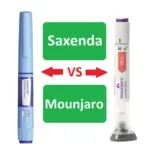Saxenda Vs Ozempic is a comparison of the two highly potent GLP-1 analogs. Both these drugs are commonly prescribed for the management of obesity and type 2 diabetes (Diabesity).
Saxenda and Ozempic are both highly potent GLP-1 analogs. These drugs lower the A1C by more than 1% and are associated with significant weight loss.
In addition, both Saxenda and Ozempic have favorable cardiovascular benefits.
Novo Nordisk manufactures both. Saxenda is mainly used for weight loss, whereas Ozempic is primarily used for the management of Diabetes Mellitus Type 2.
Saxenda Vs Ozempic: Similarities and Differences:
Saxenda and Ozempic are both incretin-mimetics. Both these drugs enhance insulin release in a glucose-dependent mechanism.
In addition, they cause fullness, early satiety, and weight loss through their direct effects on the stomach as well as via central satiety receptors in the brain.
Following are some of the similarities and differences between Saxenda and Ozempic:
Saxenda | Ozempic |
Trade Name:
| Trade name:
Other brand names:
|
Manufacturer:
| Manufacturer:
|
| Uses: To lower body weight if BMI is more than 30 or more than 27 if associated with at least one weight-related risk factor such as:
| Uses: It is used in controlling type 2 diabetes mellitus in conjunction with diet and exercise. Wegovy is a high-dose Semaglutide that has been approved for the treatment of obesity. |
Class:
| Class:
|
| Indication: It is indicated for treating obesity in patients with or without diabetes. It is indicated if the BMI is above 30 or more than 27 with at least one weight-associated medical condition. | Indication: It is FDA-approved for the treatment of diabetes with or without other anti-diabetic agents along with dietary control and lifestyle modifications. It is not approved as a weight-loss drug, however, its high dose-formulation is approved for weight loss. |
Frequency of administration:
It is available in injection form, at 6 mg/mL, and delivers the following doses:
| Frequency of administration:
It is available as a single-dose pen containing the following doses:
|
Injection method:
| Injection method:
|
Saxenda dose is titrated at weekly intervals until the maximum recommended dose while the dose of Ozempic is titrated at monthly intervals.
Saxenda dose titration:
- Week 1:
- 0.6 mg once daily
- Week 2:
- 1.2 mg once daily
- Week 3:
- 1.8 mg once daily
- Week 4:
- 2.4 mg once daily
- Week 5:
- 3 mg once daily
The dosing schedule of Ozempic is as follows:
- Week 1-4:
- 0.25 mg once weekly
- Week 5.8:
- 0.5 mg once weekly
- Week 9-12:
- 1.0 mg once weekly
- Week 13-16:
- 2.0 mg once weekly
The usual recommended dose of Ozempic is 0.5 mg or 1 mg once a week. However, recently, the maximum recommended dose has been increased to 2 mg once a week.
If blood glucose is controlled and the person is tolerating the dose adequately, lower doses can be continued.
Saxenda Vs Ozempic for Weight loss and Diabetes:
Saxenda and Ozempic are FDA-approved drugs for weight loss and diabetes respectively. Saxenda is Liraglutide which if administered in lower doses can be used to treat diabetes. Higher doses of 3 mg are recommended for weight loss.
Similarly, Ozempic is FDA-approved for the management of Diabetes. In higher doses, it is approved for weight loss (under the brand name, Wegovy).
The A1C reduction and Weight loss effects of Saxenda are summarized in the table below:
Saxenda Vs Ozempic: Effect on A1C and Weight | ||
Efficacy | Saxenda | Ozempic |
Hba1C reduction | Saxenda is not approved for diabetes. However, Liraglutide in a dose of 1.8 mg daily lowered the A1C by 1.1%. | Ozempic lowers the A1C by 1.2 – 1.8%. Ozempic 1 mg is superior to Liraglutide 1.2 and 1.8 mg in lowering A1C by 0.47% and 0.3% respectively [Ref] |
Weight loss | Saxenda reduces body weight by 7 kg (15.4 pounds). The percentage weight loss with Saxenda is estimated to be around 8 – 11% | Ozempic is associated with about 17 pounds of weight loss in actual patients. In clinical trials, it lowers body weight by 13 pounds from baseline. |
There is no doubt that Ozempic is superior to Saxenda in lowering A1C. However, the weight loss effects of both these drugs are comparable.
Ozempic, if administered in higher doses such as 2 mg or as approved for weight loss, 2.4 mg Wegovy, the weight loss effects are much greater compared to Saxenda.
Saxenda Vs Ozempic: Side effects:
Both Saxenda and Ozempic are GLP-1 analogs. They have comparable side effects profiles. However, Liraglutide (Saxenda) is administered daily and in high doses, the side effects may be more severe in these patients.
In addition, patients using Saxenda have to inject it daily. So, it is not a suitable drug for people who have needle phobia.
The side effects of both Saxenda and Ozempic are summarized here:
Saxenda Vs Ozempic: Side effects | |
Saxenda | Ozempic |
Common side effects:
| Common side effects:
|
Serious side effects:
| Serious side effects:
|
Saxenda Vs Ozempic: Drug Interactions:
Both Saxenda and Ozempic have similar interactions with other drugs because both these drugs belong to the same class of medicines called GLP-1 analogs.
Some medicines when combined with Saxend and Ozempic may cause weight gain, while others may cause hypoglycemia.
NSAIDs, and drugs that slow gastric emptying should also be avoided as they may worsen the gastrointestinal side effects of Saxenda and Ozempic.
Here is a summary of the important drug interactions:
Drug Interactions: Saxenda and Ozempic |
| Both of these are associated with severe drug reactions (especially hypoglycemia) when used along with one of the fluoroquinolones called Gatifloxacin. Both these drugs are contraindicated with Bexarotene, a drug that is used to treat skin malignancies. Both Saxenda and Ozempic should be avoided in persons using another GLP-1 analog, Dual GLP-1/GIP analog (Tirzepatide) or DPP-IV Inhibitors. |
Less Severe Drug Interactions |
Hypoglycemia:
Diuretics:
Oral, IV, and Topical corticosteroids:
Beta-agonists:
Estrogen:
Antidepressants:
|
Who should not take Saxenda and Ozempic:
Not everyone is a candidate for Saxenda or Ozempic treatment. GLP-1 analogs are contraindicated in certain medical conditions.
One should have a list of their previous and current illnesses when planning to start Ozempic or Saxenda treatment.
Here is a list of the medical conditions when these drugs may not be used:
Warnings: | |
Saxenda | Ozempic |
Saxenda should not be used if you have:
| Ozempic should not be used you have:
|
Both Saxenda and Ozempic are also contraindicated in advanced liver and kidney diseases. You should seek medical advice if you have any of the following medical conditions or complications of diabetes:
Seek medical advice: | |
Saxenda | Ozmepic |
Medical advice should be sought before using Saxenda if:
| Medical advice should be sought before using Ozempic if you:
|
- 97% Pure Berberine Powder – High-purity, plant-derived extract with a rich yellow color. Carefully processed and lab-tes…
- Naturally Bitter Taste – Berberine has a strong, naturally bitter flavor. Best enjoyed when mixed with smoothies, tea, c…
- 100g in Resealable Foil Pouch – Packaged in a premium aluminum pouch to protect from moisture and light, keeping the pow…

- 5 Delicious Flavors: Freeze-Dried Mango, Freeze-Dried Blueberry, Freeze-Dried Orange, Freeze-Dried Dragon Fruit & Freeze…
- Pure and Natural Ingredients: Our fruit powders are made without synthetic pesticides, GMOs, or harmful chemicals. Each …
- Health Benefits: Our carefully selected fruits are packed with antioxidants, vitamins, fiber, and digestive enzymes to s…

- 🌿 4 Tangy Citrus Flavors in One Pack: Enjoy a delicious variety of Orange, Lime, Lemon, and Kiwi powder – 5 sachets of e…
- 💧Easy to Mix & Refreshing: Just add to water, smoothies, sparkling drinks, or tea for a vibrant citrus kick. Dissolves i…
- 🛡️Rich in Vitamin C & Antioxidants: Made from real fruit powders, this mix offers a natural source of vitamin C to suppo…

- VARIETY PACK – Includes 5 delicious organic berry powder flavors: Freeze-Dried Goji Berry, Freeze-Dried Strawberry, Free…
- PURE INGREDIENTS – Made with 100% natural, freeze-dried berries and absolutely no added sugar, artificial ingredients, o…
- CONVENIENT PACKAGING – Contains 20 pre-portioned 5g packets (100g total), eliminating the need for measuring and ensurin…








